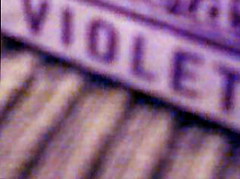Little Shop of Horrors. Orange County Performing Arts Center. Segestrom Hall.
Seeing Little Shop of Horrors in Orange County definitely underlines the urban setting and suburban dreams of this 1982 piece of 1950s B-movie nostalgia. The play takes place in a flower shop on Skid Row, where everyone wants to "get outta here" and the not-so-innocent ingenue dreams of escaping to a suburb "Somewhere that's Green" where everything is perfect because everything is the same. When the show is playing in the suburbs, that dream becomes less wistful than spooky, reminding the audience of their own cookie-cutter lifestyles and the (unfulfilled?) promises of middle class wealth in the '50s. When the humor resides in the tawdriness of this woman's dream ("a fence of real chain link" and a TV with "a big, enormous 12 inch screen"), do the wealthy audiences that will return home to their 48" plasma screens see themselves and the pathetic sameness of their suburban lives, or do they accept the success and pat themselves on the back for not living "down on Skid Row"? It's a surreal experience, seeing Little Shop of Horrors onstage in Orange County.
The production itself was quite entertaining, with the plant of course being the life of the party. Michael James Leslie was wonderful as the voice of Audrey II, and he joined puppeteers Michael Latini, Paul McGinnis, and Marc Petrosino after the show to lead a demonstration of how all the puppetry worked, which was wonderful. It's always fascinating to have some of the theatrical magic revealed, and they were generous and engaging in their demonstration, making sure the young children got to ask questions, patiently repeating themselves and providing new information when the questions were redundant, and demonstrating a lot of knowledge and pleasure for what they do and all the people who work with them. Although they did seem a little down about the future of puppetry in the face of CGI and motion capture technology. While they asserted that nothing can compare to the magic and range of expression and adaptability of live puppetry, there seemed to be a bit of discouragement about the continuing development of new jobs for puppeteers.
Jonathan Rayson as Seymour Krelbourn and Tari Kelly as Audrey were both pleasant and had wonderful voices, as did singers LaTonya Holmes (Ronnette), Amina Robinson (Crystal) and Yasmeen Sulieman (Chiffon), who do most of the storytelling work throughout the performance. James Moye played Orin the Dentist as well as almost all of the rest of the character parts in the piece, and one of the most unexpectedly amusing moments in the play was when he came onstage in a series of vignettes with rapid quickchanges in between, including an appearance in drag. Though he doesn't quite live up to Steve Martin, he was a great abusive dentist.
The one drawback of the show was its dearth of choreography; though it's not a particularly dance-driven musical, the movement in general seemed rather half-hearted and sparse. The Ronnettes especially could have used more to do in terms of movement and action to accompany their singing. Although they did their best to be both a unit and to establish individual characters, a little more coordinated movement would have helped.
Overall, though, it's a fun show and it serves a purpose; it's entertaining, and a good thing to introduce children to the theater. It also makes you think about '50s nostalgia, 'the American Dream' and how problematic any image of a squeaky clean, upwardly mobile better future can be. The cartoony, sanitized Skid Row juxtaposed with Betty Crocker Donna Reed dreams reveal both as illusions. And what does it mean that the book and music were by the creative team behind Disney musicals like Beauty and the Beast and The Little Mermaid?
Bridget Jones Mad About the Boy
-
The new Bridget Jones movie is going to do really well: Not only is it
better than it needed to be but it's landing in an anxiety-making context
where peop...
1 week ago

0 comments:
Post a Comment